|
Mystic Symbols
Religious symbolism
A
Agnus Dei
Alchemical symbols
Allah
Ankh
Astrological signs
Astrology and alchemy
Aum/Om syllable (sound
symbol)
Axis mundi
B
Bagua
Bahá'í symbols
Bhavacakra
Bindi
The most commonly used symbol is the
nine-pointed star. No particular design is
more desirable than others, as long as it has 9
points.
C
Caduceus
Celtic cross
Chai
Christian cross











Conch shell
Crescent
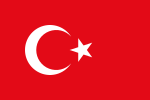
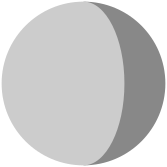

Cross and Crown

Cross and Flame

Cross of Sacrifice
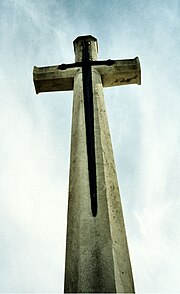
Cross of St. Peter

Cross



Crucifix



Crux Gemmata
D
Dharmacakra




Divided line of Plato
E
Eight auspicious symbols of
Tibetan Buddhism
Ek Onkar
Endless knot
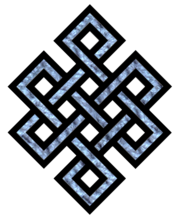
Enneagram
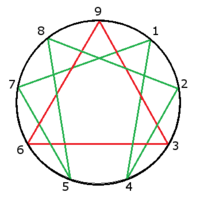




Eye of God
Eye of Horus


Eye of Providence
F
Flaming chalice


Fleur-de-lis
Flower of Life




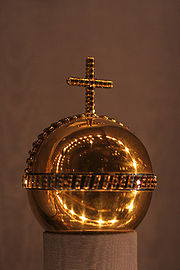

G
Globus cruciger
Golden spiral
[edit]
H
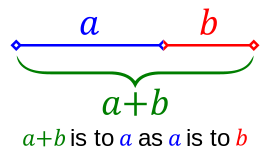

Two quantities (positive numbers) a and
b are said to be in the golden ratio

if
-

This equation unambiguously defines
 . .
The right equation shows that
 ,
which can be substituted in the left part,
giving ,
which can be substituted in the left part,
giving
-

Canceling b yields
-

Multiplying both sides by
 and rearranging terms leads to:
and rearranging terms leads to:
-

-


The only positive solution to this
quadratic equation is
-

Hands of God

Happy Human
Heart
High cross

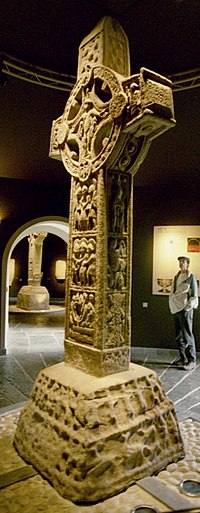
 



Holy Grail
[edit]
I
Ichthys
Infinity
[edit]
J
[edit]
K
Khamsa/Hamesh Hand/Hand of Fatima
Khanda


[edit]
L
Labarum
Labrys
Lauburu
Lingam
Lotus with Soul
[edit]
M
Maltese Cross
Mandala
Medicine wheel
Menorah
Merkaba
edit]
N
Ner tamid
Nicene Creed
Numbers as religious symbols
[edit]
O
Ouroboros
[edit]
P
Papal Cross
Patriarchal cross
Peace pipe
Pentagram
[edit]
R
Red Cross
Rod of Asclepius
[edit]
S
Sacred Heart
Sacred Chao
Scientology symbols
Shield of the Trinity
Solar symbols
Soyombo
Star
Star and crescent
Star of David
Starburst
Sun cross
Swastika
Serbian Four Cs
[edit]
T
Taijitu
Tanit symbol
Tarot deck
Tattva symbols
Tetractys
Tilaka
Torii
Tree of Life
Trefoil
Triratna/Three Jewels
Triple Goddess
Triple spiral
Triquetra
Triskelion
Turtle
[edit]
U
Urantia symbols
[edit]
V
Valknut
Vesica piscis
Vande matram
[edit]
W
White buffalo
White Rose of York
Winged Self
[edit]
Y
Yantra
Yin-yang
[edit]
Political symbols
Anarchist symbolism (including the circled "A")
Dove (used by the UK
Liberal Democrats party)
Fasces (as a symbol of
Fascism)
Hammer and sickle (as a symbol of
Communism)
Nihilism Symbol (the
nautica star or backwards "N")
Peace symbol
Pentacle of protection
Paganism
Red rose (used by the
UK Labour party)
Star (as a symbol of
Communism)
Swastika (as used by Nazis and neo-Nazis)
Torch (used by the
UK Conservative Party)
List of political party symbols in India
Elephant (used as Republican symbol in America)
Donkey (used as Democrat symbol in America)
Scientific and engineering symbols
Mathematical symbols
@ (At) Accounting Sign
Astronomical symbols
Chemical element symbols
Electrical symbols &
electronic symbols
[1]
Hazard warning symbols
Alchemical symbols
[edit]
Heraldic symbols
Heraldry
Coat of arms
Charge (heraldry)
Mon (crest)
Mullet
[edit]
Vexillological symbols (Flags)
Main article:
Vexillological symbol
[edit]
Pictograms
Main article:
Pictogram
Sports pictograms
[edit]
Other symbols
Tick (checkmark)
Jolly Roger
Skull and crossbones
"No" symbol
Power symbol
Chess symbols in Unicode
Japanese map symbols
Japanese typographic symbols
Olympic five rings symbol
Smiley Face
Period-after-opening symbol (on cosmetics as
6M,
12M,
18M etc.)
Agnus

Vicit agnus noster, eum
sequamur ("Our Lamb has conquered,
let us follow him.").
Agnus Dei, qui tollis peccata mundi, miserere
nobis.
Agnus Dei, qui tollis
peccata mundi, miserere nobis.
Agnus Dei, qui tollis peccata mundi, dona nobis
pacem.
Lamb of God, who takes away the sins of the
world, have mercy on us.
Lamb of God, who takes away the sins of the
world, have mercy on us.
Lamb of God, who takes away the sins of the
world, grant us peace. Historically, in
Requiem Masses, the first two invocations ended with "dona
eis requiem" (give them rest) instead of "miserere nobis", and
the last with "dona eis requiem sempiternam" (give them rest
eternal).
The priest again uses the
phrase "Lamb of God", in a more complete quotation from
John 1:29, when displaying the consecrated Host (or the Host
and Chalice) to the people before giving them
Holy Communion. He says: "Ecce Agnus Dei, ecce qui tollit
peccata mundi" ("Behold the Lamb of God, behold him who taketh
away the sins of the world.")
Libera meLibera me, Domine, de morte aeterna, in die
illa tremenda, quando coeli movendi sunt et terra, dum veneris
judicare saeculum per ignem. Tremens factus sum ego et timeo,
dum discussio venerit atque ventura ira. Dies illa, dies irae,
calamitatis, et miseriae, dies magna et amara valde. Requiem
aeternam dona eis, Domine: et lux perpetua luceat eis.
("Deliver me, O Lord, from eternal death on that
fearful day, when the heavens and the earth are moved, when you
will come to judge the world with fire. I am made to tremble and
I fear, because of the judgment that will come, and also the
coming wrath. That day, day of wrath, calamity, and misery, day
of great and exceeding bitterness. Grant them eternal rest, O
Lord, and let perpetual light shine upon them.")
In paradisum
In paradisum deducant te Angeli; in tuo
adventu suscipiant te martyres, et perducant te in civitatem
sanctam Jerusalem. Chorus angelorum te suscipiat, et cum Lazaro
quondam paupere aeternam habeas requiem.
("May angels lead you into Paradise; may the
martyrs receive you at your coming and lead you to the holy
city of Jerusalem. May a choir of angels receive you, and with
Lazarus, who once was poor, may you have eternal rest.")
Pie Jesu
The Pie Jesu
combines and paraphrases of the final verse of the Dies irae
and the Agnus Dei.
Pie Jesu Domine, dona eis requiem. Dona eis
requiem sempiternam.
("O sweet Lord Jesus, grant them rest; grant
them everlasting rest.")
Anglican burial service
The
Anglican
Book of Common Prayer contains seven texts which are
collectively known as "funeral sentences"; several composers
have written settings of these seven texts, which are generally
known collectively as a "burial service." Composers who have set
the Anglican burial service to music include
Thomas Morley,
Orlando Gibbons, and
Henry Purcell. The text of these seven sentences, from the
1662 Book of Common Prayer, is:
-
I am the resurrection and the life, saith
the Lord: he that believeth in me, though he were dead, yet
shall he live: and whosoever liveth and believeth in me
shall never die.
-
I know that my Redeemer liveth, and that he
shalt stand at the latter day upon the earth. And though
after my skin worms destroy this body, yet in my flesh shall
I see God: whom I shall see for myself, and mine eyes shall
behold, and not another.
-
We brought nothing into this world, and it
is certain we can carry nothing out. The Lord gave, and the
Lord hath taken away; blessed be the Name of the Lord.
-
Man that is born of a woman hath but a short
time to live, and is full of misery. He cometh up, and is
cut down, like a flower; he fleeth as it were a shadow, and
never continueth in one stay.
-
In the midst of life we are in death: of
whom may we seek for succour, but of thee, O Lord, who for
our sins art justly displeased? Yet, O Lord God most holy, O
Lord most mighty, O holy and most merciful Saviour, deliver
us not into the bitter pains of eternal death.
-
Thou knowest, Lord, the secrets of our
hearts; shut not thy merciful ears to our prayer; but spare
us, Lord most holy, O God most mighty, O holy and merciful
Saviour, thou most worthy judge eternal, suffer us not, at
our last hour, for any pains of death, to fall from thee.
-
I heard a voice from heaven, saying unto me,
Write, From henceforth blessed are the dead which die in the
Lord: even so saith the Spirit: for they rest from their
labours.


Alchemical symbols
in
Torbern Bergman's 1775 Dissertation on Elective
Affinities.
Alchemical symbol
http://en.wikipedia.org/wiki/Fire_%28classical_element%29
http://en.wikipedia.org/wiki/Fire_%28classical_element%29
Chinese
Wood (木)
| Fire (火)
Earth (土)
|
Metal (金)
|
Water (水)
Japanese
Earth (地)
|
Water (水)
| Fire (火)
|
Air / Wind (風)
|
Void / Sky / Heaven (空)
Hinduism and
Buddhism
Vayu / Pavan —
Air /
Wind
Agni /
Tejas — Fire
Akasha —
Aether
Prithvi /
Bhumi —
Earth
Ap / Jala —
Water
Tetrahedron
http://en.wikipedia.org/wiki/Tetrahedron

(Click here for rotating model)

Compound of ten tetrahedra

Compound of five tetrahedra

Two tetrahedra in a cube

Truncated tetrahedron

3.3.3
(Vertex
figure)

Self-dual
(dual
polyhedron)
http://en.wikipedia.org/wiki/Fire_%28classical_element%29
Prometheus
http://en.wikipedia.org/wiki/Prometheus

Prométhée enchaîné
(Prometheus Bound) by
Nicolas-Sébastien Adam
(1762)
http://en.wikipedia.org/wiki/Epimetheus_%28mythology%29
Epimetheus
http://en.wikipedia.org/wiki/Pandora_%28mythology%29

http://en.wikipedia.org/wiki/Alchemical_symbol
Astrological
Gold dominated by
Sol ☉ ☼ (  ) )
Silver dominated by
Luna
☽ (  ) )
Copper dominated by
Venus ♀ (also:
 ) )
Iron dominated by
Mars ♂ (  ) )
Tin dominated by
Jupiter
♃
(  ) )
Mercury (Quicksilver)
dominated by
Mercury
☿
(  ) )
Lead dominated by
Saturn
♄
(  ) )
Mundane Elements
Antimony
♁

Arsenic

Bismuth

Boron
Magnesium
⊛
Phosphorus
Platinum
☾ ☉
Potassium
Stone

Sulfur
 
Zinc
Alchemical Compounds
Sal armoniac
*
Aqua Fortis
A.F.
Aqua Regia
A.R.
Spirit of Wine
S.V.
Amalgama*Cinnabar
(Mercury
sulfide)

12 Core Alchemical processes
The 12 Alchemical
processes are considered to be the basis of modern
Chemical processes. Each of these processes is "dominated"
or "ruled" by one of the 12
Zodiac signs.
Decomposition through
Calcination (Aries
 ) )
Decomposition through
Digestion (Leo
 ) )
Decomposition through
Fermentation/Putrefaction
(Capricorn ) )
Modification through
Congelation/Coagulation (Taurus
 ) )
Modification through
Fixation (Gemini
 ) )
Modification through
Ceration (Sagittarius
 ) )
Separation through
Distillation (Virgo
 ) )
Separation through
Sublimation (Libra
 ) )
Separation through
Filtration (Scorpio
 ) )
Union through
Solution (Cancer
 ) )
Union through
Multiplication (Aquarius
 ) )
Union through
Projection (Pisces
 ) )

The word Allāh
is always written without an
alif to spell the ā vowel. This is because the
spelling was settled before Arabic spelling started habitually
using
alif to spell ā. However, in vocalized spelling, a
small diacritic alif is added on top of the
shaddah to indicate the pronunciation.
One exception may
be in the pre-Islamic
Zabad inscription, where it ends with an ambiguous sign that
may be a lone-standing h with a lengthened start, or may
be a non-standard conjoined l-h:-
as الاه : This reading would be
Allāh
spelled phonetically with alif for the ā.
as الاله : This reading would be
Al-'ilāh
= "the god", uncontracted, by older spelling practice
without alif for ā.
The form in the
inscription is shown at.[6]
Unicode has a
glyph reserved for Allāh,
ﷲ = U+FDF2,
which can be combined with an alif to yield the post-consonantal
form, اﷲ,
as opposed to the full spelling alif-lām-lām-hā
الله which may
be rendered slightly differently, in particular featuring a
diacritic alif on top of the shadda. In this,
Unicode imitates traditional Arabic typesetting, which also
frequently featured special llāh types.
In
Abjad numerals, numeric value of الله is
66.

http://en.wikipedia.org/wiki/Ankh

 -
Aries (The Ram)(cardinal, fire, personal):
Keyword: "I am". Assertive, individualistic, impulsive,
energetic, headstrong, pioneering, leader, competitive,
action-oriented, aggressive, intemperate, violent, fiery,
extreme, arrogant, quick, passionate, powerful, loner,
freedom-loving. Part of body: head/skull -
Aries (The Ram)(cardinal, fire, personal):
Keyword: "I am". Assertive, individualistic, impulsive,
energetic, headstrong, pioneering, leader, competitive,
action-oriented, aggressive, intemperate, violent, fiery,
extreme, arrogant, quick, passionate, powerful, loner,
freedom-loving. Part of body: head/skull
 -
Taurus (The Bull) (fixed, earth, personal):
Keyword: "I have". Resourceful, thorough, devotedly,
patient, indulgent, sensual, affectionate, possessive,
cautious, acquisitive, musical, artistic, stubborn, solid,
earthly, strong, sturdy, slow, kind, just. Part of body:
throat/neck -
Taurus (The Bull) (fixed, earth, personal):
Keyword: "I have". Resourceful, thorough, devotedly,
patient, indulgent, sensual, affectionate, possessive,
cautious, acquisitive, musical, artistic, stubborn, solid,
earthly, strong, sturdy, slow, kind, just. Part of body:
throat/neck
 -
Gemini (The Twins)(mutable, air, personal):
Keyword: "I think". Logical, inquisitive, lively, active,
curious, multi-tasking, talkative, sociable, duality,
mercurial, whimsical, restless, informed. Part of body:
hands/lungs, -
Gemini (The Twins)(mutable, air, personal):
Keyword: "I think". Logical, inquisitive, lively, active,
curious, multi-tasking, talkative, sociable, duality,
mercurial, whimsical, restless, informed. Part of body:
hands/lungs,
 -
Cancer (The Crab) (cardinal, water, personal):
Keyword: "I feel". Protective, sensitive, clinging,
tenacious, family and home oriented, helpful, nurturing,
moody, watery, emotional, crabby, loving. Part of
body: stomach/breasts -
Cancer (The Crab) (cardinal, water, personal):
Keyword: "I feel". Protective, sensitive, clinging,
tenacious, family and home oriented, helpful, nurturing,
moody, watery, emotional, crabby, loving. Part of
body: stomach/breasts
 -
Leo (The Lion)(fixed, fire, social): Keyword: "I
will". Generous, proud, theatrical, passionate, bossy, loves
attention, dramatic, independent, noble, creative, leader,
egotistic, sunny, bright, kingly, powerful. Part of body:
heart/back -
Leo (The Lion)(fixed, fire, social): Keyword: "I
will". Generous, proud, theatrical, passionate, bossy, loves
attention, dramatic, independent, noble, creative, leader,
egotistic, sunny, bright, kingly, powerful. Part of body:
heart/back
 -
Virgo (The Virgin) (mutable, earth, social):
Keyword: "I analyze". Practical, efficient, critical, work
and service oriented, common sense, modest, health
conscious, mentally active, fussy, helpful, loving,
flexible. Part of body: intestines/digestion -
Virgo (The Virgin) (mutable, earth, social):
Keyword: "I analyze". Practical, efficient, critical, work
and service oriented, common sense, modest, health
conscious, mentally active, fussy, helpful, loving,
flexible. Part of body: intestines/digestion
 -
Libra (The Scales) (cardinal, air, social):
Keyword: "I balance". Co-operative, fair, lazy,
partnerships, balance, grace, charm, debative, open-minded,
social, ideas. Part of body: kidneys/lumbar -
Libra (The Scales) (cardinal, air, social):
Keyword: "I balance". Co-operative, fair, lazy,
partnerships, balance, grace, charm, debative, open-minded,
social, ideas. Part of body: kidneys/lumbar
 -
Scorpio (The Scorpion) (fixed, water, social):
Keyword: "I desire". Passionate, secretive, powerful, keenly
perceptive, deep, complex, analytical, inquisitive,
resourceful, evolutionary, magnetic, intense, hypnotic,
perspicacious, creative, vigorous, untameable, cunning,
ambitious, aggressive, tyrannical, sadistic, mysterious,
transformation. Part of body: Pelvis/reproductive organs -
Scorpio (The Scorpion) (fixed, water, social):
Keyword: "I desire". Passionate, secretive, powerful, keenly
perceptive, deep, complex, analytical, inquisitive,
resourceful, evolutionary, magnetic, intense, hypnotic,
perspicacious, creative, vigorous, untameable, cunning,
ambitious, aggressive, tyrannical, sadistic, mysterious,
transformation. Part of body: Pelvis/reproductive organs
 -
Sagittarius (The Archer) (mutable, fire,
universal): Keyword: "I perceive". Free, straightforward,
careless, philosophic, intellectual, fun-loving, arrogant,
adventurous, expansive, optimistic, blundering, believer,
scattered. Part of body: hips/thighs -
Sagittarius (The Archer) (mutable, fire,
universal): Keyword: "I perceive". Free, straightforward,
careless, philosophic, intellectual, fun-loving, arrogant,
adventurous, expansive, optimistic, blundering, believer,
scattered. Part of body: hips/thighs
 -
Capricorn (The Sea-goat) (cardinal, earth,
universal): Keyword: "I use". Prudent, cautious, suspicious,
ambitious, rigid, authoritative, cunning, competent,
saturnine. Part of body: knees/skeleton -
Capricorn (The Sea-goat) (cardinal, earth,
universal): Keyword: "I use". Prudent, cautious, suspicious,
ambitious, rigid, authoritative, cunning, competent,
saturnine. Part of body: knees/skeleton
 -
Aquarius (The Water Carrier) (fixed, air,
universal): Keyword: "I know". Democratic, unconventional,
detached, friendships, humanitarian, cause-oriented, the
group, society, progressive, eccentric, elitist,
sophisticated, objective. Part of body: nervous
system/ankles -
Aquarius (The Water Carrier) (fixed, air,
universal): Keyword: "I know". Democratic, unconventional,
detached, friendships, humanitarian, cause-oriented, the
group, society, progressive, eccentric, elitist,
sophisticated, objective. Part of body: nervous
system/ankles
 -
Pisces (The Fishes)(mutable, water, universal):
Keyword: "I believe". Imaginative, sensitive, distracted,
feeling, duality, idealistic, spirituality, acceptance,
undiscriminating, soul growth, martyrdom, artistic,
neglectful, surrender, lazy, compassionate. Part of body:
feet/immune system -
Pisces (The Fishes)(mutable, water, universal):
Keyword: "I believe". Imaginative, sensitive, distracted,
feeling, duality, idealistic, spirituality, acceptance,
undiscriminating, soul growth, martyrdom, artistic,
neglectful, surrender, lazy, compassionate. Part of body:
feet/immune system
|
Number |
Sanskrit Name |
Meaning |
Western Name |
Meaning |
|
1 |
Mesha |
Ram |
Aries |
Ram |
|
2 |
Vrishabha |
Bull |
Taurus |
Bull |
|
3 |
Mithuna |
Pair |
Gemini |
Twins |
|
4 |
Karka |
Crab |
Cancer |
Crab |
|
5 |
Simha |
Lion |
Leo |
Lion |
|
6 |
Kanya |
Girl |
Virgo |
Virgin |
|
7 |
Tula |
Balance |
Libra |
Scales |
|
8 |
Vrishchika |
Scorpion |
Scorpio |
Scorpion |
|
9 |
Dhanus |
Bow, Arc |
Sagittarius |
Archer |
|
10 |
Makara |
Sea-monster |
Capricorn |
Sea-goat |
|
11 |
Kumbha |
Pitcher, Water-pot |
Aquarius |
Water-carrier |
|
12 |
Meena |
Fish |
Pisces |
Fish |
http://en.wikipedia.org/wiki/Aum


Simple Ek Onkar

Stylised Ek Onkar




Upanishads and Sutra literatureFurther information:
Mandukya Upanishad
The syllable is
mentioned in all the
Upanishads, specially elaborated upon in the
Taittiriya,
Chandogya and
Mundaka Upanishads. set forth as the object of profound
religious meditation, the highest spiritual efficacy being
attributed not only to the whole word but also to the three
sounds a (a-kāra), u (u-kāra), m
(ma-kāra), of which it consists.
The
Katha Upanishad has:
"The goal, which all
Vedas declare, which all austerities aim at, and which
humans desire when they live a life of continence, I will tell
you briefly it is Aum"
"The one syllable [evākṣara,
viz. Aum] is indeed
Brahma. This one syllable is the highest. Whosoever knows
this one syllable obtains all that he desires.
"This is the best support; this is the highest
support. Whosoever knows this support is adored in the world of
Brahma." (1.2.15-17)[2]
The
Chandogya Upanishad (1.1.1-1) states:
om ity
etad akṣaram udgītham upāsīta / om iti hy udgāyati /
tasyopavyākhyānam
"The udgitha ["the chanting", that is,
the syllable om] is the best of all essences, the highest,
deserving the highest place, the eighth."
The
Bhagavad Gita (8.13) has:
Uttering the monosyllable
Aum, the eternal world of Brahman, One who departs leaving
the body (at death), he attains the superior goal.
The
Yoga Sutras of Patanjali states in verse (1:27):
"tasya vacakah pranavah" which translates
as, "God's voice is Aum."
In the following
sutra it emphasizes, "The repetition of Om should be made
with an understanding of its meaning".
http://en.wikipedia.org/wiki/Axis_mundi
Axis Mundi

The
Caduceus
http://en.wikipedia.org/wiki/Palmette


Nike before the altar

Tree of life
http://en.wikipedia.org/wiki/Tree_of_life

The Norse Yggdasil

The Kabbalah Tree of Life
derived from the
Flower of Life.


http://en.wikipedia.org/wiki/Fleur-de-lis


http://en.wikipedia.org/wiki/Annunciation



Today is the beginning of our salvation,
The revelation of the eternal mystery!
The Son of God becomes the Son of the Virgin
As Gabriel announces the coming of Grace.
Together with him let us cry to the Theotokos:
Rejoice, O Full of Grace,
The Lord is with You!
Annunciation is
also cited in the Quran, in chapters 3 (Aal 'Imran - The family
of Imran) verses 45-51 and 19 (Maryam - Mary) verses 16-26,
although never with the mention or insinuation that Jesus is the
son of God.
From chapter 3
[45] (Remember)
when the angels said: "O Maryam (Mary)! Verily, Allâh gives you
the glad tidings of a Word ("Be!" - and he was! i.e. 'Isâ
(Jesus) the son of Maryam (Mary)) from Him, his name will be the
Messiah 'Isâ (Jesus), the son of Maryam (Mary), held in honor in
this world and in the Hereafter, and will be one of those who
are near to Allâh."
[46] "He will
speak to the people in the cradle and in manhood, and he will be
one of the righteous."
[47] She said: "O
my Lord! How shall I have a son when no man has touched me." He
said: "So (it will be) for Allâh creates what He wills. When He
has decreed something, He says to it only: "Be!" - and it is.
[48] And He
(Allâh) will teach him ('Isâ (Jesus)) the Book and Al-Hikmah
(i.e. the Sunnah, the faultless speech of the Prophets, wisdom),
(and) the Taurât (Torah) and the Injeel (Gospel).
[49] And will
make him ('Isâ (Jesus)) a Messenger to the Children of Israel
(saying): "I have come to you with a sign from your Lord, that I
design for you out of clay, a figure like that of a bird, and
breathe into it, and it becomes a bird by Allâh's Leave; and I
heal him who was born blind, and the leper, and I bring the dead
to life by Allâh's Leave. And I inform you of what you eat, and
what you store in your houses. Surely, therein is a sign for
you, if you believe.
[50] And I have
come confirming that which was before me of the Taurât (Torah),
and to make lawful to you part of what was forbidden to you, and
I have come to you with a proof from your Lord. So fear Allâh
and obey me.
[51] Truly! Allâh
is my Lord and your Lord, so worship Him (Alone). This is the
Straight Path.
From chapter 19
[16] And mention
in the Book (the Qur'ân, O Muhammad (peace be upon him) the
story of) Maryam (Mary), when she withdrew in seclusion from her
family to a place facing east.
[17] She placed a
screen (to screen herself) from them; then We sent to her Our
Ruh (angel Jibrîl (Gabriel)) and he appeared before her in the
form of a man in all respects.
[18] She said:
"Verily! I seek refuge with the Most Gracious (Allâh) from you,
if you do fear Allâh."
[19] (The angel)
said: "I am only a Messenger from your Lord, (to announce) to
you the gift of a righteous son."
[20] She said:
"How can I have a son, when no man has touched me, nor am I
unchaste?"
[21] He said: "So
(it will be), your Lord said: 'That is easy for Me (Allâh): And
(We wish) to appoint him as a sign to mankind and a mercy from
Us (Allâh), and it is a matter (already) decreed, (by Allâh).' "
[22] So she
conceived him, and she withdrew with him to a far place (i.e.
Bethlehem valley about 4-6 miles from Jerusalem).
[23] And the
pains of childbirth drove her to the trunk of a date-palm. She
said: "Would that I had died before this, and had been forgotten
and out of sight!"
[24] Then (the
babe 'Iesa (Jesus) or Jibrîl (Gabriel)) cried unto her from
below her, saying: "Grieve not: your Lord has provided a water
stream under you.
[25] "And shake
the trunk of date-palm towards you, it will let fall fresh
ripe-dates upon you."
[26] "So eat and
drink and be glad. And if you see any human being, say: 'Verily!
I have vowed a fast unto the Most Gracious (Allâh) so I shall
not speak to any human being this day.'
http://en.wikipedia.org/wiki/Nymphaea_caerulea
Egyptian blue lily
or sacred blue lily,
http://en.wikipedia.org/wiki/Gravity%27s_Rainbow
http://en.wikipedia.org/wiki/Bagua_%28concept%29
Bagua


無極生有極,
有極是太極,
太極生兩儀,
即陰陽;
兩儀生四象:
即少陰、太陰、少陽、太陽,
四象演八卦,
八八六十四卦
The Eight Trigrams (Pre-King Wen "Earlier
Heaven" order)
|
卦
Name |
自然
Nature |
Season |
性情
Personality |
家族
Family |
方位
Direction |
意義
Meaning |
|
乾Qian |
天
Heaven |
Summer |
Creative |
父
Father |
南
South |
Expansive energy, the sky. |
|
巽Xun |
風
Wind |
|
Gentle |
長女
Eldest Daughter |
西南
Southwest |
Gentle penetration, flexibility. |
|
坎Kan |
水
Water |
Autumn |
Abysmal |
中男
Middle Son |
西
West |
Danger, rapid rivers, the abyss,
the moon. |
|
艮Gen |
山
Mountain |
|
Mountain |
少男
Youngest Son |
西北
Northwest |
Stillness, immovability. |
|
坤Kun |
地
Earth |
Winter |
Receptive |
母
Mother |
北
North |
Receptive energy, that which
yields. |
|
震Zhen |
雷
Thunder |
|
Arousing |
長男
Eldest Son |
東北
Northeast |
Excitation, revolution, division. |
|
離Li |
火
Fire |
Spring |
Clinging |
中女
Middle Daughter |
東
East |
Rapid movement, radiance, the sun. |
|
兌Dui |
泽
Lake |
|
Joyous |
少女
Youngest Daughter |
東南
Southeast |
Joy, satisfaction, stagnation. |
The Eight Trigrams (King Wen "Later
Heaven" order)
|
卦名
Name |
自然
Nature |
Season |
性情
Personality |
家族
Family |
方位
Direction |
意義
Meaning |
|
離Li |
火
Fire |
Summer |
Clinging |
中女
Middle Daughter |
南
South |
Rapid movement, radiance, the sun. |
|
坤Kun |
地
Earth |
|
Receptive |
母
Mother |
西南
Southwest |
Receptive energy, that which
yields. |
|
兌Dui |
泽
Lake |
Autumn |
Joyous |
少女
Youngest Daughter |
西
West |
Joy, satisfaction, stagnation. |
|
乾Qian |
天
Heaven |
|
Creative |
父
Father |
西北
Northwest |
Expansive energy, the sky. |
|
坎Kan |
水
Water |
Winter |
Abysmal |
中男
Middle Son |
北
North |
Danger, rapid rivers, the abyss,
the moon. |
|
艮Gen |
山
Mountain |
|
Mountain |
少男
Youngest Son |
東北
Northeast |
Stillness, immovability. |
|
震Zhen |
雷
Thunder |
Spring |
Arousing |
長男
Eldest Son |
東
East |
Excitation, revolution, division. |
|
巽Xun |
風
Wind |
|
Gentle |
長女
Eldest Daughter |
東南
Southeast |
Gentle penetration, flexibility. |
 
The Greatest Name,
or more fully, the calligraphy of the Greatest Name of God, is
an
Arabic calligraphic rendering of "Yá Bahá'u'l-
 
Designed by
`Abdu'l-Bahá , the ringstone symbol, as its name
implies, is the most common symbol found on rings worn by
Bahá'ís, but it is also used on necklaces, book covers, and
paintings. It consists of two stars (haykal)
interspersed with a stylized
Bahá’. The lower line is said to represent humanity, the
upper line God, and the middle line represents the special
station of
http://en.wikipedia.org/wiki/Bhavacakra

Wheel of life
Wheel of existence
Wheel of rebirth
Wheel of
saṃsāra
Wheel of suffering
Wheel of transformation

http://en.wikipedia.org/wiki/Bindi_%28decoration%29
http://en.wikipedia.org/wiki/Caduceus

Two caduceuses without
wings as decoration of door portal in Ztracená street in
Olomouc (Czech
Republic).

Chiron and
Achilles
satyrs
(in
Greek, Σάτυροι — Sátyroi



A child satyr (center) depicted in
Titian's painting
Bacchus and Ariadne c.1520-1523
Your
continued donations keep Wikipedia running!
Satyr
From Wikipedia, the free encyclopedia
(Redirected from
Satyrs)
Jump to:
navigation,
search

Ancient Greek Satyr statuette
In
Greek mythology, satyrs (in
Greek, Σάτυροι — Sátyroi) are young humans,
possibly with horse ears, that roamed the woods and mountains,
and were the companions of
Pan and
Dionysus. In mythology they are often associated with male
sex drive and
Greco-Roman art often portrays them with
erections.
Contents
Mythology
Satyrs were
originally imagined as small, human-like creatures with very big
erections that could balance a brick. Their chief was called
Silenus, a minor deity associated (like
Hermes and the later 'Roman' god
Priapus) with fertility. These characters can be found in
the remaining Satyr plays: Cyclops by
Euripedes and
Sophocles' The Searching Satyrs. The satyr play was a
lighthearted follow-up attached to the end of each trilogy of
tragedies in Athenian festivals honoring Dionysus. These plays
would take a lighthearted approach to the heavier subject matter
of the tragedies in the series, featuring heroes speaking in
tragic
iambic verse and taking their situation seriously as
"straight men" to the flippant, irreverent and obscene remarks
and antics of the satyrs.

Image from a Greek
chalice depicting a satyr with a
tail and
erect
penis,
Euphronios,
510–500
BC,
Athens
The
groundbreaking tragic playwright
Aeschylus is said to have been especially loved for his
satyr plays, but none of them survived.

A bald, bearded, horse-tailed satyr balances a
winecup on his erect phallus, on an Attic red-figured psykter,
ca. 500-490 BC.
Satyrs acquired
their
goat aspect through later conflation with the Roman
Faunus, a carefree nature spirit of similar temperament.
Hence satyrs are most commonly described as having the upper
half of a man and the lower half of a goat. They are also
described as possessing a long, thick tail, either that of a
goat or a horse. Mature satyrs are often depicted with goat's
horns, while juveniles are often shown with bony nubs on
their foreheads.
Attic painted vases depict satyrs as being strongly built
with flat noses, large pointed ears, long curly hair, and full
beards, with
wreaths of vine or ivy circling their heads. Satyrs often
carry the
thyrsus: the rod of Dionysus tipped with a pine cone.
In some recent
works satyrs have become more human, with fewer animal
characteristics, until only the tail remains to show that they
are satyrs. In most books, drawings, etc., however, they still
have their general half-goat, half-man appearance.
They are
described as roguish but faint-hearted folk — subversive and
dangerous, yet shy and cowardly. As Dionysiac creatures they are
lovers of wine, women and boys, and are ready for every physical
pleasure. They roam to the music of pipes (auloi),
cymbals,
castanets, and
bagpipes, and love to dance with the
nymphs (with whom they are obsessed, and whom they often
pursue), and have a special form of dance called
sikinnis. Because of
their love of wine, they are often represented holding winecups,
and appear often in the decorations on winecups.
Satyrs are not
immortal, but grow old. On painted
vases and other Greek art, satyrs are represented in the
three stages of a man's life: mature satyrs are bearded, and are
shown as
balding, a humiliating and unbecoming disfigurement in Greek
culture.
In Greek mythology and art

Satyr and
maenad, shown on a red-figure Attic cup, ca. 510 BC–500 BC.,
Louvre,
Paris,
France
In earlier Greek
art, satyrs appear as old and ugly, but in later art, especially
in works of the
Attic school, this
savage characteristic is softened into a more youthful and
graceful aspect. There is a famous statue said to be a copy of a
work of
Praxiteles, representing a graceful satyr leaning against a
tree with a flute in his hand.
Older satyrs were
known as
sileni, the younger as
satyrisci. The
hare was the symbol of the shy and timid satyr. Greek
spirits known as
Calicantsars have a
noticeable resemblance to the ancient satyrs; they have goats'
ears and the feet of
donkeys or goats, are covered with hair, and love women and
the dance.
Although they are
not mentioned by
Homer, in a fragment of
Hesiod's works they are called brothers of the mountain
nymphs and
Kuretes, strongly connected with the cult of Dionysus, and
are an idle and worthless race. In the Dionysus cult, male
followers are known as satyrs and female followers as
maenads.
In Attica there
was a species of drama known as the legends of gods and heroes,
and the chorus was composed of satyrs and sileni. In the
Athenian
satyr plays of the
5th century BC, the chorus commented on the action. This
"satyric drama" burlesqued the serious events of the mythic past
with lewd
pantomime and subversive mockery. One complete satyr play
from the 5th century survives, the
Cyclops of
Euripides.
A
papyrus bearing a long fragment of a satyr play by
Sophocles, given the title 'Tracking Satyrs' (Ichneutae),
was found at
Oxyrhynchus in
Egypt,
1907.
In Roman mythology and art

A Satyr depicted on a Roman
mosaic in
Villa Romana del Casale, an archeological site near
Piazza Armerina in
Sicily,
Italy
Roman satyrs were
conflated in the popular and poetic imagination with Latin
spirits of woodland and with the rustic spirit Pan, called the
Panes

This satyr
gargoyle, affixed to the
Cathedral of St. Vincent
(Bern,
Switzerland), is posed in the act of choking a
mermaid.
Roman satyrs were
described as goatlike from the haunches to the hooves, and were
often pictured with larger horns, even
ram's horns. Roman poets often conflated them with the
fauns.
Roman
satire is a
literary form, a
poetic essay that was a
vehicle for biting, subversive social and personal criticism.
Though Roman satire is sometimes thoughtlessly linked to the
Greek satyr plays, satire's only connection to the satyric drama
is through the subversive nature of the satyrs themselves, as
forces in opposition to urbanity,
decorum, and civilization itself.
Other references
In the
King James Version of the Bible, Isaiah 13:21 and 34:14, the
English word "satyr" is used to represent the
Hebrew
sh'lrlm, "hairy
ones". In
Hebrew folklore, sh'lrlm are a type of demon or supernatural
being which inhabits waste places. There is an allusion to the
practice of sacrificing to the sh'lrlm (often translated as
"devils") in Leviticus 17:7. They correspond to the "shaggy
demon of the mountain-pass" (azabb
al-akaba) of old
Arab legend.
Christian mythology demonised all
pagan nature spirits such as satyrs by associating them with
demons and
devils, though they do resemble the Jewish goat-man demon
Azazel to whom the
scapegoats were sent.
Baby satyr
Baby satyrs,
or child satyrs, are
mythological creatures related to the satyr. They appear in
popular
folklore,
classical artworks,
film, and in various forms of local art.
Some classical
works depict young satyrs being tended to by older, sober
satyrs, while there are also some representations of child
satyrs taking part in
Bacchanalian/Dionysian
rituals (including drinking
alcohol, playing
musical instruments, and
dancing).

A child satyr (center) depicted in
Titian's painting
Bacchus and Ariadne c.1520-1523

A statue of a female satyr holding two infants
The presence of a
baby or child satyr in a classical work, such as on a
Greek vase, was mainly an aesthetic choice on the part of
the artist. However, the role of a child in Greek art might
imply a further meaning for baby satyrs:
Eros, the son of
Aphrodite, is consistently represented as a child or baby,
and Bacchus, the divine sponsor of satyrs, is seen in numerous
works as a baby, often in the company of the satyrs. A prominent
instance of a baby satyr outside
ancient Greece is
Albrecht Dürer's
1505 engraving, "Musical Satyr and Nymph with Baby (Satyr's
Family)". There is also a
Victorian-era napkin ring depicting a baby satyr next to a
barrel, which further represents the perception of baby satyrs
as partaking in the Bacchanalian festivities.
See Revivals, Reveries, and Reconstructions: Images of
Antiquity in Prints from 1500 to 1800, an exhibition at the
Philadelphia Museum of Art.
There are also
many works of art of the
rococo period depicting child or baby satyrs in Bacchanalian
celebrations. Some works depict female satyrs with their
children; others describe the child satyrs as playing an active
role in the events, including one instance of a painting by
Jean Raoux (1677–1735). "Mlle Prévost as a Bacchante"
depicts a child satyr playing a tambourine while Mlle Prévost, a
dancer at the Opéra, is dancing as part of the Bacchanal
festivities.
[1]
http://en.wikipedia.org/wiki/Celtic_cross


Celtic cross in
Père Lachaise cemetery

Celtic cross
http://en.wikipedia.org/wiki/Chai_%28symbol%29

http://en.wikipedia.org/wiki/Tetragrammaton#Jewish_use_of_the_word
Tetragrammaton

Tetragrammaton at the Roman
Catholic Church of
Saint Germain in
Paris,
France.



http://en.wikipedia.org/wiki/Tetractys


Symbol by early 17th-century Christian mystic
Jakob Böhme, including a tetractys of flaming Hebrew letters
of the Tetragrammaton.


Tetragrammaton_scripts.svg

Judaism

Maltese cross

Typical St. Florian's cross
Loyalty
Piety
Frankness
Bravery
Glory and honour
Contempt of death
Helpfulness towards the poor and the sick
Respect for the church

The Tau cross
http://en.wikipedia.org/wiki/Category:Christian_symbols
A
B
C
A
B
C
F
G
H
I
L
M
N
O
P
Q
R
S
T
http://en.wikipedia.org/wiki/Category:Abrahamic_symbols
Bahá'í symbols
I
Islamic symbols
J
Jewish symbolism
P
Palm branch (symbol)
S
Sanctuary lamp
J
[+]
Jewish symbols
http://en.wikipedia.org/wiki/Category:Religious_symbols
U
F cont.
P
R
A
F

Flaming Chalice.svg
4,518 bytes
http://en.wikipedia.org/wiki/Category:Symbols
C
D
F
G
H
I
L
M
N
P
R
S
T
U
V
*
A
B
C
D
E
F
F cont.
G
H
I
J
K
L
M
N
O
P
P cont.
R
S
T
U
V
W
Y
http://en.wikipedia.org/wiki/Crescent



The origin of the Islamic crescent
MathWorld article on geometric "Lune"
Worldwide Moon Sighting Reports

http://en.wikipedia.org/wiki/Cross_and_Crown


Cross of Sacrifice
http://en.wikipedia.org/wiki/Cross_of_St._Peter



A famous khachkar at
Goshavank (Notice the cross).
|
Cross Name |
Description |
Picture |
|
Ankh |
Also known as the Key of the Nile, the Looped
Tau Cross, and the Ansated Cross. It was an
Ancient Egyptian symbol of
life. Sometimes given a Latin name if it appears in
specifically Christian contexts, such as the crux
ansata ("handled cross"). |
 |
|
Canterbury cross |
Used in the
Anglican Churches. It has four arms of equal length,
each widening at the outer end in a hammer shape so that
their rims form a near circle. Each arm bears a
triangular panel incised with a
triquetra symbolizing the
Trinity. In the center of the cross is a small
square. The Saxon original dates from c. 850 A.D. and
was excavated in 1867 in
Canterbury, England. A stone replica can be found in
Canterbury Cathedral and in several other Anglican
cathedrals around the world.
[1]
[2] |
 |
|
Christian cross |
Also known as the Latin cross or crux
ordinaria. It is the most common symbol of
Christianity, intended to represent the redeeming
martyrdom of
Jesus when he was
crucified on the
True Cross in the
New Testament. |
 |
|
Coptic Cross |
A small circle from which emanate four arms of equal
length, with angled T shapes in the corner, cross-pieces
outward, representing the nails used in Jesus'
crucifixion. This cross receives its name from
Coptic Christianity, which centered around
Alexandria, Egypt. |
 |
|
Greek cross |
Also known as the crux immissa quadrata.
Has all arms of equal length. |
 |
|
Eastern cross |
Used in the
Eastern Orthodox Church. The top line is said to
represent the headboard, and the bottom, slanted line
represents the footrest, wrenched loose by Jesus'
writhing in intense agony. The letters IC XC found at
the end of the main arm of most Eastern Orthodox Crosses
are a
Christogram, representing the name of Jesus Christ. |
 |
|
High cross |
Free-standing
Celtic crosses commonly found in
Ireland and to a lesser extent in
Great Britain, very common in churches and
graveyards. |
 |
|
St. Brigid's Cross |
This cross is found throughout Ireland. It is told that
the cross was made by Brigid, daughter of a Pagan King
from reeds to be used as an instrument of conversion.
However, Brigid's name is derived from Brigit (also
spelled Brigid, Brìghde, Brìde, and Bríde), a Celtic
Goddess of fire, poetry, and smithcraft, and today the
cross is used to protect houses from fire. This is an
example of the integration of religious traditions. The
cross itself derives from the Indo-European Swastika, or
Solar Wheel |
 |
|
Labarum |
Constantine I's Labarum is also known as a
Chrismon, Chi-Rho (from the two
Greek letters
that make it up) or
monogram of the name Jesus Christ. Several other
forms of Chrismons exist. |
 |
|
Lebanese Forces Cross |
Inspired from the eastern crosses it symbolizes 3
things: 1- The Cross of the savior Jesus Christ In red,
the sign of martyrdom and glory. 2- The bearing cross of
the Lebanese Christians The sign of their suffering
throughout history. 3- The Diagonal cut at the base of
the cross It symbolizes the strength of the Lebanese
Christians’ will and their determination to keep the
cross planted in their region of the world. |
 |
|
Lorraine Cross |
Used in
heraldry. It is similar to a
patriarchal cross, but usually has one bar near the
bottom and one near the top, rather than having both
near the top. |
 |
|
Marian Cross |
Etched on the casket of
Pope John Paul II, the Marian Cross is a
Catholic adaptation of the traditional Latin cross
to emphasize Catholic devotion to
Mary. |
 |
|
Nordic Cross |
Used in
flags descended from the
Dannebrog. |
 |
|
Papal Cross |
The three cross-bars represent the Roman Catholic Pope's
triple role as Bishop of Rome, Patriarch of the West,
and successor of St. Peter, Chief of the Apostles. |
 |
|
Patriarchal cross |
Similar to a traditional Christian cross, but with an
additional, smaller crossbar above the main one meant to
represent all the Orthodox Christian Archbishops and
Patriarchs. In the Eastern Orthodox Church, this cross
is sometimes seen with an additional, slanted bar near
the foot of the cross (see Byzantine Cross). This cross
is similar to the Lorraine Cross and the Caravaca Cross. |
 |
|
Presbyterian Cross |
Used by
Presbyterian denominations. |
 |
|
Red Cross |
Used as a symbol for medical care in most of the world,
the
Red Crescent being used in Islamic countries and the
Magen David Adom in
Israel. |
 |
|
Cross of Sacrifice |
A Latin cross with a superimposed sword, blade down. It
is a symbol used by the
Commonwealth War Graves Commission at the site of
many war memorials. |
 |
|
Flag of Queen Tamar |
Used in
Georgia as national flag, first used by
Georgian King
Vakhtang Gorgasali in
5th century and later adopted by Queen
Tamar of Georgia in
13th century. The flag depicts a Jerusalem cross,
adopted during the reign of
George V of Georgia who drove out the
Mongols from Georgia in
1334. |
 |
|
Saint Andrew's Cross |
Used in
Scotland's national flag and the naval ensign of the
Russian Navy, it is also called the
Saltire, the Boundary Cross (because it
was used by the Romans as a barrier) and the crux
decussata.
Saint Andrew is believed to have suffered a martyr's
death on such a cross, hence its name. The cross does
not have to be at this particular angle to qualify as a
saltire; the symbol
X can also be considered a St. Andrew's Cross. |
 |
|
St George's Cross |
Used in
England's national flag. |
 |
|
Saint Peter's Cross |
An upside-down Latin cross, based on a tradition that
holds that
Saint Peter was martyred by being crucified
upside-down. Today it is often associated with
anti-Christian or
Satanic groups. |
 |
|
Skull and crossbones |
Not a cross as such, but a saltire made of bones, with
an overlaid skull. Traditionally used by
pirates. It was actually relatively rarely used by
pirates, each ship having its own design, often
involving an
hourglass. |
 |
|
Sun cross |
Also known as the Sunwheel, solar cross or
Odin's cross, because
Odin's symbol in
Norse mythology was a cross in a circle. |
 |
|
Tau Cross |
Also known as
Saint Anthony's Cross, the Egyptian Cross
and the crux commissa. It is shaped like
the letter
T.
Francis of Assisi used it as his signature. |
 |
|
Thieves' Cross |
Also known as the Furka Cross. The
fork, shaped like the letter
Y.
[3] |
|
|
Mariner's Cross |
The Mariner's Cross is a stylized cross in the
shape of an
anchor. The
Mariner's Cross is also referred to as
St. Clement's Cross in reference to the way he
was martyred. |
 |
|
Bent cross |
Also known as the
swastika, it is an equilateral cross with its
arms bent at right angles in either left-facing or
right-facing direction. The swastika is a holy symbol in
Hinduism,
Jainism and
Buddhism. In the West, it is more widely known as a
symbol of
Nazism. It is also used in
Heathenry. It is traditionally oriented so that a
main line is horizontal, though it is occasionally
rotated at forty-five degrees, and the Hindu version is
often decorated with a dot in each quadrant. The Nazi
swastika always faces right, which has led to the
decreased use of the right-facing version of this cross
as religious symbols outside of India. They are now
mostly left-facing. |
 |
|
Persian cross |
Carved into mountainside at the site of the tombs of the
Achaemenian Kings |
 |
Written crosses
are used for many different purposes, particularly in
mathematics.
The
Roman numeral for
ten is
X.
In the
Latin alphabet, the letter
X and the minuscule form of
t are crosses.
The Chinese character for ten is
十;
(see
Chinese numerals).
The
dagger or
obelus (†)
The
addition (or
plus) sign (+) and the
multiplication (or
times) sign (×).
If n≥1 is an
integer, the numbers
coprime to
n, taken
modulo
n, form a
group with multiplication as operation; it is written as
(Z/nZ)× or Zn*.
A cross is often
used as a
check mark because it can be clearer, easier to create with
an ordinary pen or pencil, and less obscuring of the text or
image that is already present than a large dot. It also allows
marking a position more accurately than a large dot.
A large cross
through a text often means that it is wrong or should be
considered deleted.
http://en.wikipedia.org/wiki/Crucifix


Michelangelo's
Creation of Adam, from the
Sistine Chapel. Michelangelo shows God creating Adam, with
Eve in His arm. While not strictly true to the Genesis account,
this is one of the most famous depictions of the creation of
Adam and Eve in Western art.
Adam
(Hebrew:
אָדָם, "man";
Arabic: آدم;
Ge'ez:) and Eve (Hebrew:
חַוָּה,
Ḥavva,
"living one";
Arabic: حواء, Hawwa;
Ge'ez: ሕይዋን, Hiywan) were the
first man and woman created by
God according to the
Bible and the
Qur'an.

A Crux gemmata
http://en.wikipedia.org/wiki/Category:Christian_iconography

http://en.wikipedia.org/wiki/Iconography
http://en.wikipedia.org/wiki/Dharmacakra



http://en.wikipedia.org/wiki/The_divided_line_of_Plato



http://en.wikipedia.org/wiki/Endless_knot
"an ancient symbol
representing the interweaving of the Spiritual Path, the flowing
of Time and Movement within That Which is Eternal. All
existence, it says, is bound by time and change, yet ultimately
rests serenely within the Divine, the Eternal, Buddha, the Mind
of God."
"Addiction and
aversion lead to delusion, which is the ongoing source of all
suffering."
The inter-twining of wisdom and compassion;
represents the mutual dependence of religious doctrine and
secular affairs
The union of wisdom and method
The inseparability of emptinesss (shunyata)
and Dependent Co-arrising (Pratitya-samutpada
at the time of the path)
At the time of enlightenment the union of
wisdom and great compassion
Symbolic of knot symbolism in linking
ancestors and
omnipresence and the magical ritual and
meta-process
of
binding (refer etymology of
Tantra,
Yoga and
religion) (see
Namkha)
Since the knot has no beginning or end it
also symbolizes the infinite wisdom of the Buddha.
http://en.wikipedia.org/wiki/Gordian_knot




Some brief
descriptions of the Enneatypes are as follows:

One: Reformer, Critic,
Perfectionist - This type focuses on integrity. Ones can be
wise, discerning and inspiring in their quest for the truth.
They also tend to dissociate themselves from their flaws or what
they believe are flaws (such as negative emotions) and can
become hypocritical and hyper-critical of others, seeking the
illusion of virtue to hide their own vices. The One's greatest
fear is to be flawed and their ultimate goal is perfection. The
corresponding "deadly sin" Ones is Anger and their "holy
idea" or essence is Holy Perfection. Under stress Ones
express qualities of Fours and when relaxed qualities of Sevens.

Two: Helper, Giver, Caretaker
- Twos, at their best, are compassionate, thoughtful and
astonishingly generous; they can also be prone to
passive-aggressive behavior, clinginess and manipulation.
Twos want, above all, to be loved and needed and fear being
unworthy of love. The corresponding "deadly sin" of Twos is
Pride and their "holy idea" or essence is Holy Will.
Under stress Twos express qualities of Eights and when relaxed
qualities of Fours.

Three: Achiever, Performer,
Succeeder - Highly adaptable and changeable. Some walk the
world with confidence and unstinting authenticity; others wear a
series of public masks, acting the way they think will bring
them approval and losing track of their true self. Threes are
motivated by the need to succeed and to be seen as successful.
The corresponding "deadly sin" of Threes is Deceit and
their "holy idea" or essence is Holy Law. Under stress
Threes express qualities of Nines and when relaxed qualities of
Sixes.

Four: Romantic, Individualist,
Artist - Driven by a desire to understand themselves and
find a place in the world they often fear that they have no
identity or personal significance. Fours embrace individualism
and are often profoundly creative and intuitive. However, they
have a habit of withdrawing to internalize, searching
desperately inside themselves for something they never find and
creating a spiral of depression. The corresponding "deadly sin"
of Fours is Envy and their "holy idea" or essence is
Holy Origin. Under stress Fours express qualities of Twos
and when relaxed qualities of Ones.

Five: Observer, Thinker,
Investigator - Fives are motivated by the desire to
understand the world around them, specifically in terms of
facts. Believing they are only worth what they contribute, Fives
have learned to withdraw, to watch with keen eyes and speak only
when they can shake the world with their observations. Sometimes
they do just that. However, some Fives are known to withdraw
from the world, becoming reclusive hermits and fending off
social contact with abrasive cynicism. Fives fear incompetency
or uselessness and want to be capable and knowledgeable above
all else. The corresponding "deadly sin" of the Five is
Avarice and their "holy idea" or essence is Holy
Omniscience. Under stress Fives express qualities of Sevens
and when relaxed qualities of Eights.

Six: Loyalist, Devil's
Advocate, Defender - Sixes long for stability above all
else. They exhibit unwavering loyalty and responsibility, but
once betrayed, they are slow to trust again. They are prone to
extreme anxiety and
passive-aggressive behavior. Their greatest fear is to lack
support and guidance. The corresponding "deadly sin" of the Six
is Cowardice and their "holy idea" or essence is Holy
Faith and Strength. Under stress Sixes express qualities of
Threes and when relaxed qualities of Nines. There are two kinds
of Sixes - phobic and counterphobic. Phobic Sixes have a
tendency to run or hide from things they fear while
counterphobic Sixes are more likely to confront their fears.

Seven: Enthusiast, Adventurer,
Materialist, Epicure - Sevens are adventurous, and busy with
many activities with all the energy and enthusiasm of the
Puer Aeternus. At their best they embrace life for its
varied joys and wonders and truly live in the moment; but at
their worst they dash frantically from one new experience to
another, too scared of disappointment to actually enjoy
themselves. Sevens fear being unable to provide for themselves
or to experience life in all of its richness. The corresponding
"deadly sin" of Sevens is Gluttony and their "holy idea"
or essence is Holy Wisdom". Under stress Sevens express
qualities of Ones and when relaxed qualities of Fives.

Eight: Leader, Protector,
Challenger - Eights value personal strength and they desire
to be powerful and in control. They concern themselves with
self-preservation. They are natural leaders, who can be either
friendly and charitable or dictatorially manipulative, ruthless,
and willing to destroy anything in their way. Eights seek
control over their own lives and destinies, and fear being
harmed or controlled by others. The corresponding "deadly sin"
of the Eight is Lust and their "holy idea" or essence is
Holy Truth. Under stress Eights express qualities of
Fives and when relaxed qualities of Twos.

Nine: Mediator, Peacemaker,
Preservationist - Nines are ruled by their empathy. At their
best they are perceptive, receptive, gentle, calming and at
peace with the world. On the other hand, they prefer to
dissociate from conflicts; they indifferently go along with
others' wishes, or simply withdraw, acting via inaction. They
fear the conflict caused by their ability to simultaneously
understand opposing points of view and seek peace of mind above
all else. The corresponding "deadly sin" of the Nine is Sloth
and their "holy idea" or essence is Holy Love. Under
stress Nines express qualities of Sixes and when relaxed
qualities of Threes.
The circled
dot, circumpunct, or circle with a point at its
centre. It is an ancient symbol.
It can symbolize:
The
sun:
See also
Solar symbol


http://en.wikipedia.org/wiki/Eye_of_Providence




Aachen Cathedral







Emblem of the Parc naturel régional du
Queyras



Octahedron (Animation)

The
vesica piscis
http://en.wikipedia.org/wiki/Sacred_geometry




http://en.wikipedia.org/wiki/Globus_cruciger


The globus cruciger was
used in the
Byzantine Empire, as shown in this coin of Emperor
Leontius (d. 705).
http://en.wikipedia.org/wiki/Golden_ratio

The golden section is a line segment
sectioned into two according to the golden ratio. The
total length a+b
is to the longer segment a
as a is to the
shorter segment b.


The golden
ratio is defined algebraically as

The right
equation shows that  ,
which can be substituted in the left part, giving ,
which can be substituted in the left part, giving

Canceling b
yields

Multiplying both
sides by  and
rearranging terms leads to: and
rearranging terms leads to:

The only positive
solution to this
quadratic equation is


Mathematician
Mark Barr proposed using the first letter in the name of
Greek sculptor
Phidias, phi, to symbolize the golden ratio. Usually,
the lowercase form (φ) is used. Sometimes, the uppercase form
(Φ) is used for the
reciprocal of the golden ratio, 1/φ .


Depiction of the proportions in a medieval
manuscript, that according to
Jan Tschichold feature a "Page proportion 2:3. Margin
proportions 1:1:2:3. Text area proportioned in the Golden
Section."[23]
Australian sculptor
Andrew Rogers's 50-ton stone and gold sculpture, entitled
Golden Ratio, is installed outdoors in
Jerusalem. Rogers donated the sculpture. The height of each
stack of stones, beginning from either end and moving toward the
center, is the beginning of the
Fibonacci sequence: 1, 1, 2, 3, 5, 8.
Conjugate golden ratio
The negative root
of the quadratic equation for φ (the "conjugate root") is  . The negative of this quantity corresponds to
the length ratio taken in reverse order (shorter segment length
over longer segment length, b/a), and is sometimes referred to
as the golden ratio conjugate.[1]
It is denoted here by the capital Phi (Φ): . The negative of this quantity corresponds to
the length ratio taken in reverse order (shorter segment length
over longer segment length, b/a), and is sometimes referred to
as the golden ratio conjugate.[1]
It is denoted here by the capital Phi (Φ):

Alternatively,
Φ can be expressed as

This illustrates
the unique property of the golden ratio among positive numbers,
that

or its inverse:

Short proofs of irrationality
Recall that we
denoted the "larger part" by a and the "smaller part" by
b, and defined:

Multiplying both
sides by ab leads to:

Subtracting ab
from both sides and factoring out a gives:

Finally reversing
sides and dividing both by b(a-b) delivers the equivalent
form:

This gives a
short proof that the golden ratio is an
irrational number. An irrational number is one that cannot
be written as a/b where a and b are
integers. If a/b is such a fraction, in
lowest terms, then b/(a − b) is an
equivalent fraction with a smaller numerator, which is a
contradiction. Thus this number cannot be written in this form,
and is therefore irrational.
Another short
proof — perhaps more commonly known — of the irrationality of
the golden ratio makes use of the
closure of rational numbers under addition and
multiplication. If  is rational, then is rational, then  is
also rational, which is a contradiction if it is already known
that the square root of a non-square
natural number is irrational. is
also rational, which is a contradiction if it is already known
that the square root of a non-square
natural number is irrational.
Alternate forms
The formula  can be expanded recursively to obtain a
continued fraction for the golden ratio: can be expanded recursively to obtain a
continued fraction for the golden ratio:
![\varphi = [1; 1, 1, 1, \dots] = 1 + \frac{1}{1 + \frac{1}{1 + \frac{1}{1 + \cdots}}}](MYSTICAL%20SYMBOLS_files/image316.gif)
and its
reciprocal:
![\varphi^{-1} = [0; 1, 1, 1, \dots] = 0 + \frac{1}{1 + \frac{1}{1 + \frac{1}{1 + \cdots}}}\,.](MYSTICAL%20SYMBOLS_files/image317.gif)
The
convergents of these continued fractions (1, 2, 3/2, 5/3,
8/5, 13/8, ..., or 1, 1/2, 2/3, 3/5, 5/8, 8/13, ...) are ratios
of successive Fibonacci numbers.
The equation  likewise produces the continued
square root form: likewise produces the continued
square root form:

Also:



These correspond
to the fact that the length of the diagonal of a regular
pentagon is φ times the length of its side, and similar
relations in a
pentagram.
If x
agrees with  to
n decimal places, then to
n decimal places, then  agrees
with it to 2n decimal places. agrees
with it to 2n decimal places.
An equation
derived in 1994 connects the golden ratio to the
Number of the Beast (666):[1]

Which can be
combined into the expression:


Ptolemy's theorem
The golden ratio
can also be found by applying
Ptolemy's theorem to the quadrilateral formed by removing
one vertex from a regular pentagon. If the quadrilateral's long
edge and diagonals are b, and short edges are a,
then Ptolemy's theorem says b2 = a2 + ab
which yields

Geometry


Slavic solar symbol found on the
Zbruch Idol


Some forms of the
triple spiral or
triskelion signs are sometimes considered to be solar
symbols. The triskelion on the
flag of Ingushetia is given this meaning.

The
swastika can be derived from the sun cross, and is another
solar symbol in some contexts.[citation
needed] It is used (not as a solar symbol in
particular) among
Buddhists,
Jains, and
Hindus (see
manji) in addition to its infamous
Nazi associations.



High Cross, Dysert, Co.
Clare, Ireland

Cross of the Scriptures,
Clonmacnoise, Ireland

Kildalton Cross, Islay
Scotland AD 800

Muiredach's Cross and West
Cross at Monasterboice, Co Louth, Ireland
http://en.wikipedia.org/wiki/Holy_Grail

How at the Castle of
Corbin a Maiden Bare in the Sangreal and Foretold the
Achievements of Galahad: illustration
by
Arthur Rackham, 1917


The Damsel of the Sanct
Grael by
Dante Gabriel Rossetti

(16th century illuminated,
heraldic,
stained glass panel, depicting the Holy Grail) and the
coat of arms of
Sir Robert Bell

Infinity is often
used not only to define a limit but as if it were a value in the
extended real numbers in
real analysis; if f(t) ≥ 0 then
 means
that f(t) does not bound a finite area from 0
to 1 means
that f(t) does not bound a finite area from 0
to 1
 means
that the area under f(t) is infinite. means
that the area under f(t) is infinite.
 means
that the area under f(t) equals 1 Infinity is also
used to describe
infinite series: means
that the area under f(t) equals 1 Infinity is also
used to describe
infinite series:
 means
that the sum of the infinite series
converges to some real value
x. means
that the sum of the infinite series
converges to some real value
x.
 means
that the sum of the infinite series
diverges in the specific sense that the partial sums
grow without bound. means
that the sum of the infinite series
diverges in the specific sense that the partial sums
grow without bound.
http://en.wikipedia.org/wiki/Infinity
Ley lines
Fractal
Folk mathematics
Proportion (architecture)
Platonic solids
Golden ratio
Golden spiral
Astrological aspects
Pythagorean symbols
About Sacred Geometry by Mika Feinberg
Dodecahedron by Jason Martineau
Sacred Geometry Home Page by Bruce Rawles
Sacred Geometry: The Architecture Of The Universe by
Charles Gilchrist
Sacred Geometry - What is it? by Catherine Yronwode
Sacred Geometry of Islamic Mosques
Geometry in Art & Architecture
The Sacred Geometry of Crop Circles by
Freddy Silva
MAGIC POINT Sacred Geometry by Richard Donald
Sacred geometry at the
Open Directory Project
(suggest
site)
Article - Sacred Geometry of Carbon Atom
http://en.wikipedia.org/wiki/Category:Esoteric_cosmology
http://en.wikipedia.org/wiki/Category:Numerology
http://en.wikipedia.org/wiki/Category:Numbers
http://en.wikipedia.org/wiki/Category:Pythagorean_philosophy
http://en.wikipedia.org/wiki/Category:Philosophy_of_mathematics
http://en.wikipedia.org/wiki/Category:Branches_of_philosophy
http://en.wikipedia.org/wiki/Category:Scientific_disciplines
http://en.wikipedia.org/wiki/Category:Branches_of_psychology
http://en.wikipedia.org/wiki/Category:Branches_of_sociology
http://en.wikipedia.org/wiki/Category:Science
http://en.wikipedia.org/wiki/Category:Academic_disciplines
http://en.wikipedia.org/wiki/Category:Knowledge
http://en.wikipedia.org/wiki/Category:Mathematics
http://en.wikipedia.org/wiki/Category:Abstraction
http://en.wikipedia.org/wiki/Category:Thought
http://en.wikipedia.org/wiki/Category:Theology
|